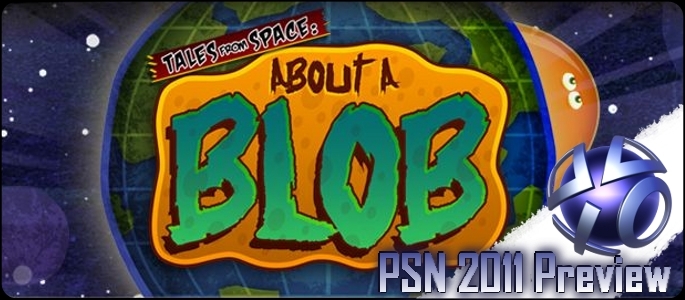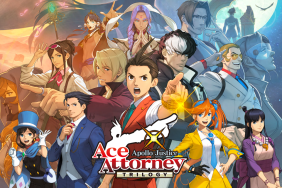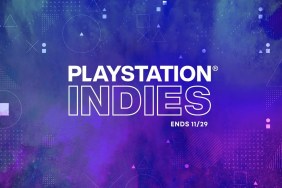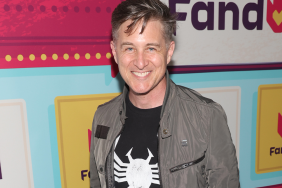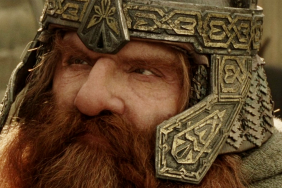Developed by DrinkBox Studios, Tales from Space: About a Blob is a Sony Pub Funded PlayStation Network exclusive that follows a blob who arrives on Earth no bigger than a hamster, but as it eats its surroundings, ultimately grows to the size of a planet. The co-op supporting puzzle-platformer spices up gameplay with various powers that are gained as the game progresses. With a loveable classic monster-movie theme and a retro art style, the game received high praise from our E3 preview.
To learn more about the game, the possibility of future “Tales from Space” games, and the benefits of PS+, PlayStation LifeStyle chatted with Chris Harvey, Technical Lead at DrinkBox Studios and Design Lead for About a Blob.
Hi Chris, could you start by introducing yourself and telling us about your role at Drinkbox?
Hi! My name is Chris Harvey, and I’m the Technical Lead at DrinkBox Studios. I also acted as the Design Lead on Tales from Space: About a Blob. We’re a small team over here so people end up wearing a lot of different hats.
As you eat your surroundings, you grow and grow – just how large can your blob become?
There are four chapters in the game. At the end of the first chapter you’re about the size of a person. By the end of the second chapter you’re around the size of a tank. By the end of the third chapter you’re around the size of a house. Finally, by the end of the fourth and final chapter you’re around the size of the Earth. Something to keep in mind is that at the start of each chapter the blob starts off very small in a new location, so each chapter has more and more growth within it.
The game will include various powers for your blob, which one is your favourite?
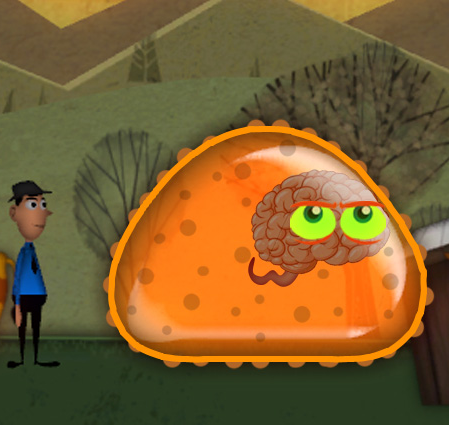
Just to recap for people who might not be aware, the blob’s basic abilities allow him to absorb and spit out objects. In addition, over the course of the game you pick up a Magnetic ability and an Electric ability. The Magnetic ability lets you pull and push small magnetic objects, and stick or repel from large magnetic objects. The Electric ability lets you manipulate simple machines using electricity as a resource.
I think overall the Magnetic power is my favourite. The first chapter of the game is very much a physics platformer with an absorption and growth mechanic. Once you get the Magnetic ability the levels open up a lot more and I think the platforming starts to feel especially unique. I believe the rest of the team would agree with that, because once we completed a first pass of the game we ended up going back and adding a lot more magnetic platforming based on the group’s feedback.
Why do you think that co-op is such a rarity in games?
I think co-op requires a lot of commitment, and when you start to add up all the work involved you suddenly have a lot of reasons not to do it. The enemies and bosses need to work with multiple people. The platforming, puzzles, and other challenges all need to handle multiple players. There are major performance issues that can appear, and the level designers and programmers need to test everything in both single player and co-op. Of course, the thing about co-op is that there’s all this ‘free’ fun that comes from having another person there to help (or to hinder), and there are lots of games that are just much more fun with multiple people. After we prototyped co-op we knew it would be a bit painful to implement in the final game, but we found it so fun that it was really important to us to keep it in. In fact I definitely encourage people to play through About a Blob in co-op if at all possible.
Did you encounter many difficulties as a designer when implementing co-op?
Because our game is very physics oriented, and because having two players on-screen at the same time makes more of the level visible, we had to worry a lot more about performance in co-op. There were lots of changes required to levels because you could squish the blobs together in ways that caused big performance problems. About a Blob has a lot of puzzles, and so there was a lot of work done to make sure the puzzles wouldn’t break in two-player, or be really easy in one mode but not the other. Similarly, there are a number of moments we call ‘forced progressions’ in the game, where something is chasing the player and they have to move and think quickly to survive. We had to constantly test and adjust these to try and make sure they were reasonable for two players to complete.
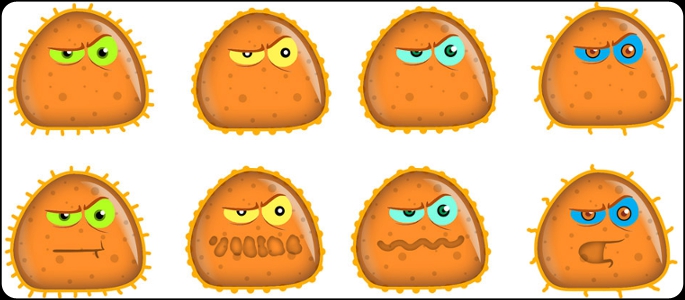
Can you eat other player’s blobs?
Unfortunately no. That’s actually something we talked a lot about, but in the end we felt that while awesome, it was too disruptive to the game. However you can stand on, push against, slam into, or otherwise squish other players. This is important for collection and cooperation in the game, and also opens up the door for players to fight with each other. In fact, to encourage competition there’s a gauge at the top of the screen in co-op to tell you who’s playing better.
Can you tell us about some of the concepts for different blobs that were considered before settling on the final design?
Strangely enough the initial design for the blob was orange and pretty similar to what we ended up with, although his facial expressions expanded and became less sad and scared.
Along the way we tried a bunch of different looks. There was a blob with a solid core inside, various squishy types of blobs, a blob with a visible brain (the brain was supposed to be the reason he’s able to solve puzzles), blobs with various kinds of mouths, blobs with nodules on the skin, and blobs that could stick on weapons or use objects as a shield.
In the end we tried all these things but kept coming back to the initial simple look we had originally. We think that some of the other ideas we had are pretty funny though, so we’re planning to add the ability to modify the look of the blob in an upcoming game update. Hopefully we’ll have a more formal announcement about that soon.

The game obviously takes inspiration from classic monster movies – is the game filled with Easter eggs?
There are lots of little references littered throughout the game. Some refer to monster movies or other kinds of fiction, and there are a lot of Internet memes hidden around. Our art director is a fan of wordplay, so I think you’ll find a lot of that around the levels.
Is ‘Tales from Space’ destined to become a game franchise?
If our next game fits into the concept of Tales from Space I think we’ll put it under that umbrella, although we’re not going to shoehorn something if it doesn’t fit.
We like the idea of an easy way for people to identify our games. When I play a game I enjoy, particularly with smaller downloadable games where the personality of the team is important, I find myself looking for other games that team has made. Q-Games, which makes the PixelJunk series, has done a great job at making it easy to find their stuff on PSN and so I think we’re taking a cue from them.
About a Blob is a Sony Pub-fund game, would you consider using the same fund for your next
game?
Yes I think we’d be happy to use Pub Fund again. Sony has been great to work with, and they’ve provided lots of useful input and feedback.
Game development is an incredibly risky proposition. The industry is very hit-driven, and you usually have to spend a lot of money and time before you get the chance to make anything back. I know it may seem crass to reduce it to dollars and cents like that, but the failure of a single game often spells doom for companies.
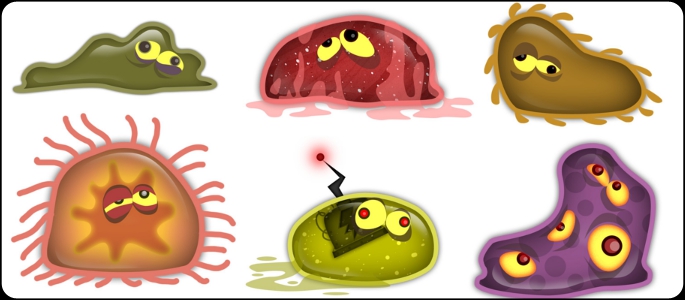
Pub Fund has been great for us because we know the minimum amount of money the game will return, and we can plan accordingly. Also, because Sony has a direct interest in the success game they have a reason to try and be extra helpful. The downsides from our perspective are that we’re exclusive to a single platform, and we must complete the project using our own money before we can get paid. So while we’re unlikely go out and buy gold-plated Ferrari’s based on this game, we also know we won’t have to live out of cardboard boxes either. I think that’s a trade-off that sits well with our team. At this point we’re just happy to have the chance to keep making games of our own.
Do you believe Sony supports indie developers more than other platform holders?
Well, I don’t want to step on anyone’s toes, but I think an argument can definitely be made that they are more directly supportive. Obviously the App Store and Steam are very indie friendly because there’s a lower barrier to getting your game accepted. But I think that if you look at the PSN Store you’ll find Sony has been willing to take some real risks with the games they’ve taken on. I mean, Linger in Shadows is not a very traditional game and was actually published by Sony. Flower, Flow, and Everyday Shooter are also really non-traditional and again were published by Sony. So on PSN not only are they allowing unique games like these to be released, but they are actively courting the developers. On PSN it’s still relatively easy to self-publish, and strangely that’s not the case everywhere. Finally Sony has in-between publishing and self-publishing programs like Pub Fund, which are attractive and helpful to indie teams. When you take that all together I think it forms a compelling argument. I could go on for a pretty long time about this, but I’ll try to restrain myself and stop there.
Whose idea was it to release a week early on the PS+, yours or Sony’s? And what benefits does such a promotion bring?
That was an idea Sony suggested. I think it’s helpful to them since it reinforces the idea of PS+ as a premium subscription with special advantages. In addition to the early release on PS+ we’ll be releasing some PS+ exclusive content as well. On our side it’s an opportunity to get a bit more advertising support from Sony, and since ad space can be expensive or hard to come-by it’s definitely attractive. I also think PS+ subscribers are likely to be people who play a lot of different games, so it probably doesn’t hurt to give them some extra attention.
Have you finalised a price yet?
I don’t think it’s completely locked down yet, but it should be soon.
PlayStation LifeStyle would like to thank Chris Harvey for taking time out of his busy schedule to answer the interview questions and Chris McQuinn for setting the interview up.
About a Blob will release in North America on February 1st for PlayStation Plus users, and to regular PSN subscribers a week later.
